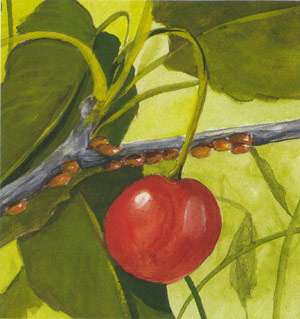
Many people in the Northeast were puzzled last July to find a shiny, sticky goo coating the leaves of all kinds of trees. When the cause was discovered, it just made the situation more baffling. An astounding number of tiny insects riddled the undersides of tree leaves. What were they, and how could there suddenly be so many of them?
They were, we soon learned, the immature, or “crawler,” stage of the European fruit lecanium scale. The scientists who study them also have good reason to find them confusing: first of all, though long thought to be from Europe, there is now consensus that this is a native insect that has instead migrated in the other direction.
Lecanium scales will survive and multiply on almost any and every woody plant. Depending on the host species, the very same insect species can be quite variable in color, size, and shape. Indeed, the apparent differences within this species sometimes are greater than those between it and other lecanium species.
All of the many types of scale insects are in the family Homoptera, a generally unpopular group of plant feeders whose best-known members are the aphids.
The female lecanium scale, having overwintered on a twig, matures in spring and develops a hard, turtle-shaped shell, about a seventh of an inch long. At this point, she looks a bit like a small ladybug that has been glued to the twig. Most likely, she has not mated and will reproduce parthenogenetically, as her generic name – Parthenolecanium – suggests. She lays eggs – sometimes more than 1,000 of them – beneath her protective shell and then dies and dries up. In a week to 10 days, the eggs hatch, and tiny, yellowish hatchlings crawl out from the shell and onto a nearby leaf.
A scale insect’s immediate goal is to grow and develop, and for this it needs nitrogen, an essential part of all animal protein. This element is much scarcer in plant sap than are carbohydrates, such as sugar, which explains the stickiness of scale insects’ excretion and also why the stickiness is called “honeydew.”
Once the crawlers have inserted their sucking mouthparts, called stylets, into a leaf, they stay put all summer, taking in sap and excreting honeydew. As they grow and molt, their legs become smaller and their bodies larger. In late summer, before the leaves drop, they pull up stakes and migrate down the leaf stalk to settle for the winter on twigs. The females will not move again.
Normally, lecanium scales are kept at low levels by parasites and predators, though they have great reproductive potential when an opportunity arises. They seem uninterested in moving any farther than the distance across a maple leaf or two, so how on earth did they manage to appear in droves all across the landscape in the sticky summer of 2005? Have they existed unseen in all these places in very small numbers? If so, the unexplained environmental or biological influences that conspired to tip the balance in the scales’ favor must have been at work across several states. Or do they instead have an efficient, hidden distribution system that spreads them across the region, such as on chickadee feet or the wind? So far, no answers to these questions are in sight.
The copious honeydew that the scales excrete is often colonized by a sooty mold, and this made it easy to find infested trees from afar last November because their twigs were blackened. When I took a closer look, it revealed hundreds of old scale shells still stuck to the darkened twigs. After clipping some branches and bringing them indoors, I saw that about 80 percent of the old scale shells had the telltale exit holes that could only have been made by parasitic wasps.
This means that on the ridge behind our house, at least, the lecanium scale infestation would have been far worse if these parasites had not been on the job. The exit holes indicate a successful wasp hatch, so if you were to judge from the collection of maple, ash, and black cherry twigs that were spread out on our kitchen table, lecanium parasites will be abundant in 2006. I wish them bon appétit!


Discussion *